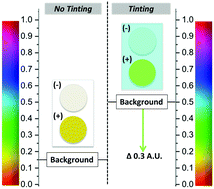Our official English website, www.x-mol.net, welcomes your feedback! (Note: you will need to create a separate account there.)
Color manipulation through microchip tinting for colorimetric detection using hue image analysis
Lab on a Chip ( IF 6.1 ) Pub Date : 2017-10-25 00:00:00 , DOI: 10.1039/c7lc00796e Shannon T. Krauss 1, 2, 3, 4 , Aeren Q. Nauman 3, 4, 5 , Gavin T. Garner 2, 3, 4, 6 , James P. Landers 1, 2, 3, 4, 6
Lab on a Chip ( IF 6.1 ) Pub Date : 2017-10-25 00:00:00 , DOI: 10.1039/c7lc00796e Shannon T. Krauss 1, 2, 3, 4 , Aeren Q. Nauman 3, 4, 5 , Gavin T. Garner 2, 3, 4, 6 , James P. Landers 1, 2, 3, 4, 6
Affiliation

|
Colorimetry with microfluidic devices has been proven to be an advantageous method for in situ analyses where limited resources and rapid response for untrained users are desired. Image analysis using a small camera or cell phone can be easily incorporated for an objective readout, eliminating variations from normal differences in color perception and environmental factors during analysis. The image analysis using the parameter hue, for example, has been utilized as a highly effective, objective analysis method that correlates with the psychological way color is perceived. Hue analysis, however, is best used for colorimetric reactions that result in distinct changes from one color to a markedly different color and can be inadequate to distinguish between subtle or monotonal (colorless-to-colored) color changes. We address this with three unique color manipulation (i.e., tinting) techniques that provide greater discrimination with such color changes, thus yielding improved limits of detection for various colorimetric reactions that may have previously been limited. Tinting is invoked through dyeing the reagent substrate, colored printing the device, or colored lighting during image capture, and is shown to effectively shift the background color of the reaction detection area. Hydrogen peroxide, a constituent of peroxide-based explosives, is associated with a monochromatic color change upon reaction, and this is used to demonstrate the effectiveness of the tinting methods in improving the limit of detection from an undetectable color change to 0.1 mg mL−1.
中文翻译:

通过微芯片着色进行色彩处理,使用色相图像分析进行比色检测
用微流体装置进行比色法已被证明是原位检测的一种有利方法分析需要有限资源和对未经培训的用户做出快速响应的地方。使用小型相机或手机进行图像分析可以轻松地进行客观的读数,从而消除了分析过程中色彩感知和环境因素的正常差异带来的变化。例如,使用参数色相的图像分析已被用作一种高效的客观分析方法,该方法与感知颜色的心理方式相关。但是,色相分析最适合用于比色反应,该比色反应会导致从一种颜色到明显不同的颜色发生明显的变化,并且可能不足以区分细微的或单调的(无色到有色)颜色变化。我们通过三种独特的颜色处理(即(着色)技术可对此类颜色变化提供更大的辨别力,从而提高了以前可能受到限制的各种比色反应的检测限。通过对试剂底物染色,对设备进行彩色打印或在图像捕获期间进行彩色照明来调用着色,并且可以有效地改变反应检测区域的背景色。过氧化氢是过氧化物基炸药的一种成分,与反应后的单色变化有关,这可用于证明着色方法在将检测限从不可检测的颜色变化提高到0.1 mg mL -1方面的有效性。。
更新日期:2017-10-26
中文翻译:

通过微芯片着色进行色彩处理,使用色相图像分析进行比色检测
用微流体装置进行比色法已被证明是原位检测的一种有利方法分析需要有限资源和对未经培训的用户做出快速响应的地方。使用小型相机或手机进行图像分析可以轻松地进行客观的读数,从而消除了分析过程中色彩感知和环境因素的正常差异带来的变化。例如,使用参数色相的图像分析已被用作一种高效的客观分析方法,该方法与感知颜色的心理方式相关。但是,色相分析最适合用于比色反应,该比色反应会导致从一种颜色到明显不同的颜色发生明显的变化,并且可能不足以区分细微的或单调的(无色到有色)颜色变化。我们通过三种独特的颜色处理(即(着色)技术可对此类颜色变化提供更大的辨别力,从而提高了以前可能受到限制的各种比色反应的检测限。通过对试剂底物染色,对设备进行彩色打印或在图像捕获期间进行彩色照明来调用着色,并且可以有效地改变反应检测区域的背景色。过氧化氢是过氧化物基炸药的一种成分,与反应后的单色变化有关,这可用于证明着色方法在将检测限从不可检测的颜色变化提高到0.1 mg mL -1方面的有效性。。



























 京公网安备 11010802027423号
京公网安备 11010802027423号